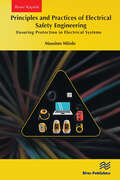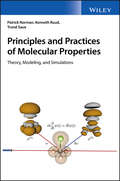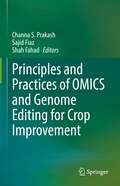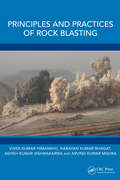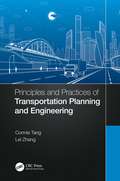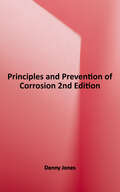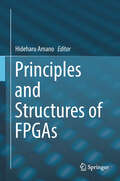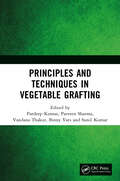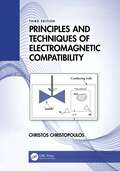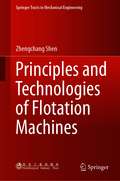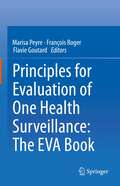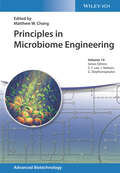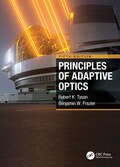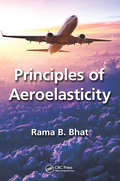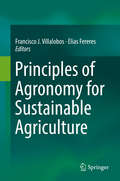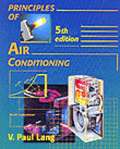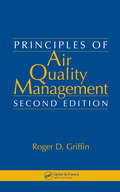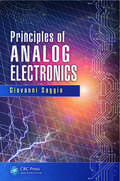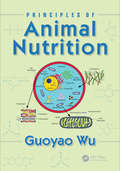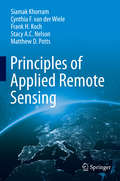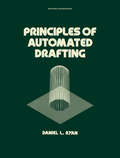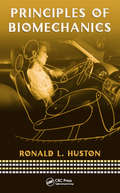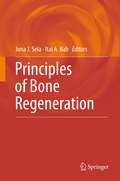- Table View
- List View
Principles and Practices of Electrical Safety Engineering: Ensuring Protection in Electrical Systems
by Massimo MitoloElectrical safety is a critical component of modern engineering, vital for protecting both persons and property from the inherent hazards of electrical systems. This book delves into the core principles and practical applications of electrical safety engineering, offering invaluable insights for engineers, technicians, and students alike.Inside this book, you will find: In-depth explanations and visual aids: Numerous explanatory figures accompany detailed discussions on key concepts, making complex ideas accessible and understandable. Protective measures and risk assessment: Explore standard and advanced protective measures, fault protection systems, and thorough risk assessment methodologies to ensure the safety and reliability of electrical systems. Safety-by-design principles: Learn how to integrate safety considerations from the earliest stages of design, creating inherently safer electrical systems. Authored by a leading expert in the field, this book is an essential resource for anyone involved in the design, operation, or maintenance of electrical systems. Equip yourself with the knowledge and tools to ensure electrical safety and contribute to the advancement of safer electrical practices worldwide.Principles and Practices of Electrical Safety Engineering is your definitive guide to mastering the critical aspects of electrical safety, offering both theoretical foundations and practical solutions to meet the demands of today's complex electrical environments.
Principles and Practices of Molecular Properties: Theory, Modeling, and Simulations
by Patrick Norman Kenneth Ruud Trond SaueA comprehensive yet accessible exploration of quantum chemical methods for the determination of molecular properties of spectroscopic relevance Molecular properties can be probed both through experiment and simulation. This book bridges these two worlds, connecting the experimentalist's macroscopic view of responses of the electromagnetic field to the theoretician’s microscopic description of the molecular responses. Comprehensive in scope, it also offers conceptual illustrations of molecular response theory by means of time-dependent simulations of simple systems. This important resource in physical chemistry offers: A journey in electrodynamics from the molecular microscopic perspective to the conventional macroscopic viewpoint The construction of Hamiltonians that are appropriate for the quantum mechanical description of molecular properties Time- and frequency-domain perspectives of light–matter interactions and molecular responses of both electrons and nuclei An introduction to approximate state response theory that serves as an everyday tool for computational chemists A unified presentation of prominent molecular properties Principles and Practices of Molecular Properties: Theory, Modeling and Simulations is written by noted experts in the field. It is a guide for graduate students, postdoctoral researchers and professionals in academia and industry alike, providing a set of keys to the research literature.
Principles and Practices of OMICS and Genome Editing for Crop Improvement
by Shah Fahad Channa S. Prakash Sajid FiazGlobal food security is increasingly challenging in light of population increase, the impact of climate change on crop production, and limited land available for agricultural expansion. Plant breeding and other agricultural technologies have contributed considerably for food and nutritional security over the last few decades. Genetic engineering approaches are powerful tools that we have at our disposal to overcome substantial obstacles in the way of efficiency and productivity of current agricultural practices. Genome engineering via CRISPR/Cas9, Cpf1, base editing and prime editing, and OMICs through genomics, transcriptomics, proteomics, phenomics, an metabolomics have helped to discover underlying mechanisms controlling traits of economic importance. Principle and Practices of OMICs and Genome Editing for Crop Improvement provides recent research from eminent scholars from around the world, from various geographical regions, with established expertise on genome editing and OMICs technologies. This book offers a wide range of information on OMICs techniques and their applications to develop biotic, abiotic and climate resilient crops, metabolomics and next generation sequencing for sustainable crop production, integration bioinformatics, and multi-omics for precision plant breeding. Other topics include application of genome editing technologies for food and nutritional security, speed breeding, hybrid seed production, resource use efficiency, epigenetic modifications, transgene free breeding, database and bioinformatics for genome editing, and regulations adopted by various countries around globe for genome edited crops. Both OMICs and genome editing are vigorously utilized by researchers for crop improvement programs; however, there is limited literature available in a single source. This book provides a valuable resource not only for students at undergraduate and postgraduate level but also for researchers, stakeholders, policy makers, and practitioners interested in the potential of genome editing and OMICs for crop improvement programs.
Principles and Practices of Rock Blasting
by Arvind Kumar Mishra Vivek Kumar Himanshu Narayan Kumar Bhagat Ashish Kumar VishwakarmaThis book enriches the readers with the advances in rock blasting techniques for mining and civil construction rock excavation projects, including the need for and importance of rock blasting, related theories, challenges in rock blasting operations, and rock blasting methodology for excavation of coal and overburden benches of opencast coal mines. It also discusses methods to estimate charge factors and dimensional parameters for different rock types of iron ore mines, blasting methodology for rock strata and the blasting technologies for civil construction projects.The book:Provides comprehensive review of the prediction methodologies of blasting results.Reviews insights into advanced blasting methodologies for rock excavation near sensitive structures.Includes case studies of coal mining, iron ore mining, limestone mining and civil construction projects.Explores the detailed theoretical background of rock blasting.Discusses methodologies of secondary blasting.This book is aimed at graduate students and researchers in mining, geotechnical, and rock engineering.
Principles and Practices of Transportation Planning and Engineering
by Lei Zhang Connie TangConnie Kelly Tang and Lei Zhang have provided a holistic coverage of the entire surface transportation project and program development process from the beginning of planning though environmental approval, design, right-of way acquisition, construction to operations and maintenance.— Neil Pedersen, Executive Director, Transportation Research Board, National Academies of Sciences, Engineering, and Medicine, Washington, DC Transportation program and project development is complex. The process spans over planning, programming, environment, design, right of way, construction, operations, and maintenance. Professionals from civil engineering, planning, social and environmental sciences, business and project management, and data science, work together in a relay team to transform an idea into a highway, a transit hub, an airport or a water facility. It is challenging for any one person to master all the knowledge and skills needed to perform every relevant task. However, it is critical for all involved to understand how this relay works and how the societal, environmental, governmental, and regulatory contexts influence the process and the technical solution. Professionals who understand the process and see the big picture are those who rise to the top as leaders. Transportation Project and Program Development provides holistic coverage on the technical subject matter, processes and procedures, and policy and guidance associated with transportation project and program development, which can help professionals become program leaders. For each phase of the process, key products delivered, processes used, governing principles, foundations of applicable science and engineering, technologies deployed, and knowledge required are discussed. While all coverages reflect the practices of the United States, the logic, principles, science, and engineering are applicable to all countries of the world. The book can also serve as an introductory textbook for undergraduate students and as a textbook or reference for a graduate-level course in civil engineering, transportation engineering, planning, and project management.
Principles and Prevention of Corrosion, 2nd Edition
by Denny JonesFor a senior/graduate-level course in corrosion. Comprehensive in approach, this text explores the scientific principles and methods that underlie the cause, detection, measurement, and prevention of many metal corrosion problems in engineering practice. Most chapters progress from qualitative, descriptive sections (including methods of prevention and testing) to more quantitative sections (involving metallurgy and electrochemistry) and, finally, to sections on current research developments in the chapter topic.
Principles and Structures of FPGAs
by Hideharu AmanoThis comprehensive textbook on the field programmable gate array (FPGA) covers its history, fundamental knowledge, architectures, device technologies, computer-aided design technologies, design tools, examples of application, and future trends. Programmable logic devices represented by FPGAs have been rapidly developed in recent years and have become key electronic devices used in most IT products. This book provides both complete introductions suitable for students and beginners, and high-level techniques useful for engineers and researchers in this field. Differently developed from usual integrated circuits, the FPGA has unique structures, design methodologies, and application techniques. Allowing programming by users, the device can dramatically reduce the rising cost of development in advanced semiconductor chips. The FPGA is now driving the most advanced semiconductor processes and is an all-in-one platform combining memory, CPUs, and various peripheral interfaces. This book introduces the FPGA from various aspects for readers of different levels. Novice learners can acquire a fundamental knowledge of the FPGA, including its history, from Chapter 1; the first half of Chapter 2; and Chapter 4. Professionals who are already familiar with the device will gain a deeper understanding of the structures and design methodologies from Chapters 3 and 5. Chapters 6–8 also provide advanced techniques and cutting-edge applications and trends useful for professionals. Although the first parts are mainly suitable for students, the advanced sections of the book will be valuable for professionals in acquiring an in-depth understanding of the FPGA to maximize the performance of the device.
Principles and Techniques in Vegetable Grafting
by Sunil Kumar Pardeep Kumar Parveen Sharma Vandana Thakur Binny VatsWritten out of extensive research on vegetable grafting, this book contains current scientific and applied practical knowledge about its various aspects. A discussion of various practical issues pertinent to the field is carried out, and topics such as rootstocks and their significance, various methods of grafting, use of robotic machines, potential contribution of grafting and future perspectives of this technique towards improvement of vegetable production are also discussed.This book is aimed at aimed at both the people involved in the commercial production and cultivation of grafted plants as well as researchers interested in the understanding of the science and technology behind a grafted plant.Print edition not for sale in South Asia (India, Sri Lanka, Nepal, Bangladesh, Pakistan or Bhutan)
Principles and Techniques of Electromagnetic Compatibility (Electronic Engineering Systems)
by Christos ChristopoulosThis book provides a sound grasp of the fundamental concepts, applications, and practice of EMC. Developments in recent years have resulted in further increases in electrical component density, wider penetration of wireless technologies, and a significant increase in complexity of electrical and electronic equipment. New materials, which can be customized to meet EMC needs, have been introduced. Considerable progress has been made in developing numerical tools for complete system EMC simulation. EMC is now a central consideration in all industrial sectors. Maintaining the holistic approach of the previous edition of Principles and Techniques of Electromagnetic Compatibility, the Third Edition updates coverage of EMC to reflects recent important developments. What is new in the Third Edition? A comprehensive treatment of new materials (meta- and nano-) and their impact on EMC Numerical modelling of complex systems and complexity reduction methods Impact of wireless technologies and the Internet of Things (IoT) on EMC Testing in reverberation chambers, and in the time-domain A comprehensive treatment of the scope and development of stochastic models for EMC EMC issues encountered in automotive, railway, aerospace, and marine applications Impact of EMC and Intentional EMI (IEMI) on infrastructure, and risk assessment In addition to updating material, new references, examples, and appendices were added to offer further support to readers interested in exploring further. As in previous editions, the emphasis is on building a sound theoretical framework, and demonstrating how it can be turned to practical use in challenging applications. The expectation is that this approach will serve EMC engineers through the inevitable future technological shifts and developments.
Principles and Technologies of Flotation Machines (Springer Tracts in Mechanical Engineering)
by Zhengchang ShenThis book highlights the principles and technologies of flotation machine mainly used in mineral processing in detail. Froth flotation is one of the most important mineral processing techniques. Over 90% of the nonferrous minerals and 50% of the ferrous minerals in the world are treated using flotation: a complicated technique including procedures from chemistry, physics and multi-scale fluid mechanics. The book introduces readers to air-forced and air-induced flotation cells and discusses the various mechanical structures and working principles involved. A number of examples from industrial engineering practice are also discussed throughout the book, helping readers to better understand the technology and relevant equipment. The book is intended for researchers, professionals and graduate students in the fields of mining and mineral processing engineering.
Principles for Evaluation of One Health Surveillance: The EVA Book
by Marisa Peyre François Roger Flavie GoutardThis book outlines essential elements of the evaluation of health surveillance within the One Health concept. It provides an introduction to basic theoretical notions of evaluation and vividly discusses related challenges. Expert authors cover the entire spectrum of available, innovative methods, from those for system process evaluations to methods for the economic evaluation of the surveillance strategies. Each chapter provides a detailed description of the methodology required and the tools available as illustrated by practical examples of animal health or One Health surveillance evaluations in both developed and developing countries.Targeting not only scientists, including epidemiologists, but also technical advisers of decision-makers, the present work is suitable for the evaluation of any type of health surveillance system - animal, human or combined - regardless of the socio-economic context. The volume is richly equipped with practical tools and examples, which enables the reader to apply the methods described. Increasing importance of health surveillance, and threats from disease outbreaks such as the coronavirus pandemic, underline the practical relevance of this work, which will fill an important gap in the literature.
Principles in Microbiome Engineering (Advanced Biotechnology)
by Jens Nielsen Gregory Stephanopoulos Sang Yup LeePrinciples in Microbiome Engineering Provides an overview of the techniques and applications insight into the complex composition and interactions of microbiomes Microbiomes, the communities of microorganisms that inhabit specific ecosystems or organisms, can be engineered to modify the structure of microbiota and reestablish ecological balance. In recent years, a better understanding of microbial composition and host-microbe interactions has led to the development of new applications for improving human health and increasing agricultural productivity and quality. Principles in Microbiome Engineering introduces readers to the tools and applications involved in manipulating the composition of a microbial community to improve the function of an eco-system. Covering a range of key topics, this up-to-date volume discusses current research in areas such as microbiome-based therapeutics for human diseases, crop plant breeding, animal husbandry, soil engineering, food and beverage applications, and more. Divided into three sections, the text first describes the critical roles of systems biology, synthetic biology, computer modelling, and machine learning in microbiome engineering. Next, the volume explores various state-of-the-art applications, including cancer immunotherapy and prevention of diseases associated with the human microbiome, followed by a concluding section offering perspectives on the future of microbiome engineering and potential applications. Introduces a variety of applications of microbiome engineering in the fields of medicine, agriculture, and food and beverage products Presents current research into the complex interactions and relationships between microbiomes and biotic and abiotic elements of their environments Examines the use of technologies such as Artificial Intelligence (AI), Machine Learning (ML), and Big Data analytics to advance understanding of microbiomes Discusses the engineering of microbiomes to address human health conditions such as neuro psychiatric disorders and autoimmune and inflammatory diseases Edited and authored by leading researchers in the rapidly evolving field, Principles in Microbiome Engineering is an essential resource for biotechnologists, biochemists, microbiologists, pharmacologists, and practitioners working in the biotechnology and pharmaceutical industries.
Principles of Adaptive Optics
by Robert K. Tyson Benjamin West FrazierPrinciples of Adaptive Optics describes the foundations, principles, and applications of adaptive optics (AO) and its enabling technologies. This leading textbook addresses the fundamentals of AO at the core of astronomy, high-energy lasers, biomedical imaging, and optical communications. Key Features: Numerous examples to explain and support the underlying principles Hundreds of new references to support the topics that are addressed End-of-chapter questions and exercises A complete system design example threaded through each chapter as new material is introduced
Principles of Aeroelasticity
by Rama B. BhatIntroductory Guide on the Design of Aerospace Structures Developed from a course taught at Concordia University for more than 20 years, Principles of Aeroelasticity utilizes the author’s extensive teaching experience to immerse undergraduate and first-year graduate students into this very specialized subject. Ideal for coursework or self-study, this detailed examination introduces the concepts of aeroelasticity, describes how aircraft lift structures behave when subjected to aerodynamic loads, and finds its application in aerospace, civil, and mechanical engineering. The book begins with a discussion on static behavior, and moves on to static instability and divergence, dynamic behavior leading up to flutter, and fluid structure interaction problems. It covers classical approaches based on low-order aerodynamic models and provides a rationale for adopting certain aeroelastic models. The author describes the formulation of discrete models as well as continuous structural models. He also provides approximate methods for solving divergence, flutter, response and stability of structures, and addresses non-aeroelastic problems in other areas that are similar to aeroelastic problems. Topics covered include: The fundamentals of vibration theory Vibration of single degree of freedom and two degrees of freedom systems Elasticity in the form of an idealized spring element Repetitive motion Flutter phenomenon Classical methods, Rayleigh-Ritz techniques, Galerkin’s technique, influential coefficient methods, and finite element methods Unsteady aerodynamics, and more
Principles of Aeroelasticity (Dover Books on Engineering)
by Holt Ashley Raymond L. BisplinghoffPrinciples of Aeroelasticity constitutes an attempt to bring order to a group of problems which have coalesced into a distinct and mature subdivision of flight vehicle engineering. The authors have formulated a unifying philosophy of the field based on the equations of forced motion of the elastic flight vehicle. A distinction is made between static and dynamic phenomena, and beyond this the primary classification is by the number of independent space variables required to define the physical system.Following an introductory chapter on the field of aeroelasticity and its literature, the book continues in two major parts. Chapters 2 through 5 give general methods of constructing static and dynamic equations and deal specifically with the laws of mechanics for heated elastic solids, forms of aerodynamic operators, and structural operators. Chapters 6 through 10 survey the state of aeroelastic theory. The chapters proceed from simplified cases which have only a small, finite number of degrees of freedom, to one-dimensional systems (line structures), and finally to two-dimensional systems (plate- and shell-like structures).Chapter 9 combines some of the previous results by treating the unrestrained elastic vehicle in flight. All these chapters assume linear systems with properties independent of time, but Chapter 10 takes up the subject of systems which must be represented by nonlinear equations or by equations with time varying coefficients.
Principles of Agronomy for Sustainable Agriculture
by Francisco J. Villalobos Elias FereresThis textbook explains the various aspects of sustainable agricultures to undergraduate and graduate students. The book first quantifies the components of the crop energy balance, i. e. the partitioning of net radiation, and their effect on the thermal environment of the canopy. The soil water balance and the quantification of its main component (evapotranspiration) are studied to determine the availability of water to rain fed crops and to calculate crop water requirements. Then it sets the limitations of crop production in relation to crop phenology, radiation interception and resource availability (e. g. nutrients). With that in mind the different agricultural techniques (sowing, tillage, irrigation, fertilization, harvest, application of pesticides, etc. ) are analyzed with special emphasis in quantifying the inputs (sowing rates, fertilizer amounts, irrigation schedules, tillage plans) required for a given target yield under specific environmental conditions (soil & climate). For all techniques strategies are provided for improving the ratio productivity/resource use while ensuring sustainability. The book comes with online practical focusing on the key aspects of management in a crop rotation (collecting weather data, calculating productivity, sowing rates, irrigation programs, fertilizers rates etc).
Principles of Agronomy for Sustainable Agriculture
by Francisco J. Villalobos Elias FereresThis updated second edition textbook explains the different technologies of agronomy to achieve a more sustainable agriculture, for undergraduate and graduate students of agronomy. The first section gives an overview of the crop energy balance, which covers partitioning of net radiation, and their effect on the thermal environment of the canopy. Water balance, as one of the biggest concerns under a changing climate, will also be thoroughly discussed. For the second section, the authors prepare all relevant information on crop production in relation to crop phenology, radiation interception and resource availability. With that in mind, the different agricultural techniques are analyzed in the third section, with special emphasis on quantifying the inputs required for a given target yield under specific environmental conditions. For each technique, the chapters provide guidance on improving the ratio between productivity and resource use, while ensuring sustainability.
Principles of Air Conditioning (5th Edition)
by V. Paul LangThis proven text, now in its fifth edition, covers the fundamental principles of refrigeration and air conditioning. The material is intended to help learner develop practical skills required in all areas of A/C applications; design, installation, sales, & service. The technical information presented is fundamental to all types of domestic & commercial systems.
Principles of Air Quality Management
by Roger D. GriffinBlending information from popular mainstream articles, highly technical publications, and research journals, the second edition of Principles of Air Quality Management features new sections on air toxics, new information on chronic and acute health effects, and new approaches to the assessment of those impacts on sensitive populations. It em
Principles of Analog Electronics
by Giovanni SaggioRichly illustrated in full color, this textbook introduces you to the fascinating world of analog electronics, where fields, circuits, signals and systems, and semiconductors meet. The author expertly blends theory with practical examples to give a clear understanding of how real electronic circuits work. The book reviews the prerequisite mathematics, physics, and chemistry and the theory of circuits before delving into passive and active electronic devices. Taking a fresh approach, it connects electronics to everyday life through interesting observations, key personalities, and real-world applications.
Principles of Animal Nutrition
by Guoyao WuAnimals are biological transformers of dietary matter and energy to produce high-quality foods and wools for human consumption and use. Mammals, birds, fish, and shrimp require nutrients to survive, grow, develop, and reproduce. As an interesting, dynamic, and challenging discipline in biological sciences, animal nutrition spans an immense range from chemistry, biochemistry, anatomy and physiology to reproduction, immunology, pathology, and cell biology. Thus, nutrition is a foundational subject in livestock, poultry and fish production, as well as the rearing and health of companion animals. This book entitled Principles of Animal Nutrition consists of 13 chapters. Recent advances in biochemistry, physiology and anatomy provide the foundation to understand how nutrients are utilized by ruminants and non-ruminants. The text begins with an overview of the physiological and biochemical bases of animal nutrition, followed by a detailed description of chemical properties of carbohydrates, lipids, protein, and amino acids. It advances to the coverage of the digestion, absorption, transport, and metabolism of macronutrients, energy, vitamins, and minerals in animals. To integrate the basic knowledge of nutrition with practical animal feeding, the book continues with discussion on nutritional requirements of animals for maintenance and production, as well as the regulation of food intake by animals. Finally, the book closes with feed additives, including those used to enhance animal growth and survival, improve feed efficiency for protein production, and replace feed antibiotics. While the classical and modern concepts of animal nutrition are emphasized throughout the book, every effort has been made to include the most recent progress in this ever-expanding field, so that readers in various biological disciplines can integrate biochemistry and physiology with nutrition, health, and disease in mammals, birds, and other animal species (e.g., fish and shrimp). All chapters clearly provide the essential literature related to the principles of animal nutrition, which should be useful for academic researchers, practitioners, beginners, and government policy makers. This book is an excellent reference for professionals and a comprehensive textbook for senior undergraduate and graduate students in animal science, biochemistry, biomedicine, biology, food science, nutrition, veterinary medicine, and related fields.
Principles of Applied Remote Sensing
by Siamak Khorram Frank H. Koch Cynthia F. van der Wiele Stacy A. C. Nelson Matthew D. PottsThis textbook is one of the first to explain the fundamentals and applications of remote sensing at both undergraduate and graduate levels. Topics include definitions and a brief history of payloads and platforms, data acquisition and specifications, image processing techniques, data integration and spatial modeling, and a range of applications covering terrestrial, atmospheric, oceanographic and planetary disciplines. The policy and law issues of remote sensing and the future trends on the horizon are also covered. Remote sensing is an exciting, dynamic technology that is transforming the Earth sciences - terrestrial, atmospheric, and marine - as well as the practices of agriculture, disaster response, engineering, natural resources, providing evidence in legal cases and documented humanitarian crises, and many other fields. Increasingly, understanding of these techniques will be central to a number of disciplines, particularly as the technology advances.
Principles of Automated Drafting (Mechanical Engineering Ser. #28)
by Daniel L. RyanThis book introduces the reader to each phase of the subject, step-by-step to enable one to use the various automated drafting devices, instruments and technique of application. It shows the way to produce acceptable drafting in the framework of high productivity.
Principles of Biomechanics
by Ronald HustonResearch and study in biomechanics has grown dramatically in recent years, to the extent that students, researchers, and practitioners in biomechanics now outnumber those working in the underlying discipline of mechanics itself. Filling a void in the current literature on this specialized niche, Principles of Biomechanics provides readers with a so
Principles of Bone Regeneration
by Jona J. Sela Itai A. BabPrinciples of Bone Regeneration is a timely publication that addresses the modern aspects of bone healing and repair. This exciting new volume details the convergence of the different experimental and clinical approaches designed for the study and treatment of bone healing in its diverse forms and under varying conditions. Bone healing is affected by a multitude of genetic, environmental, mechanical, cellular and endocrine variables which eventually lead to changes in gene expression that enhance the guided action of osteoblasts (and chondroblasts) to lay down bone that restores, or even improves, the skeletal load bearing capacity. Recent breakthroughs in understanding the regulatory aspects of bone formation and resorption, in both research and clinical arenas offer new modalities to induce, enhances and guide repair processes in bone for the benefit of millions of patients with conditions such as nonunion fractures, critical size defects, orthodontic tooth movement, periodontal bone loss, intraosseous implants and deformed bones.
